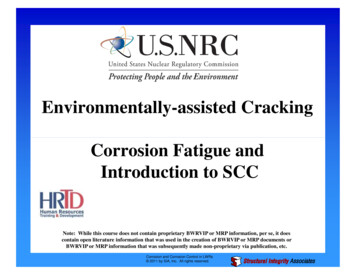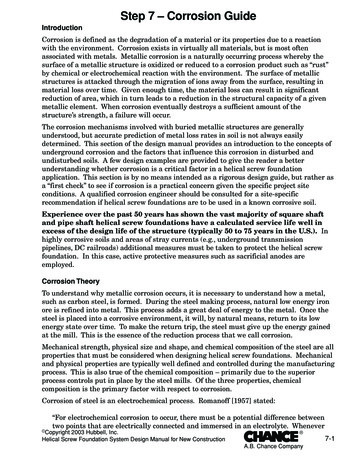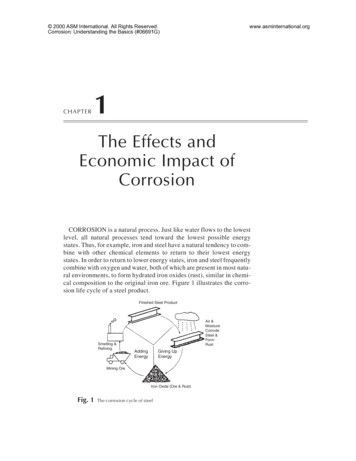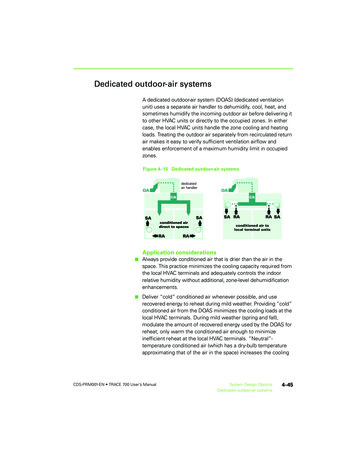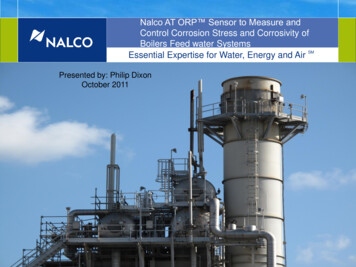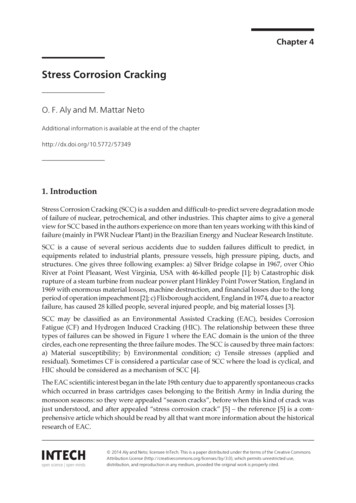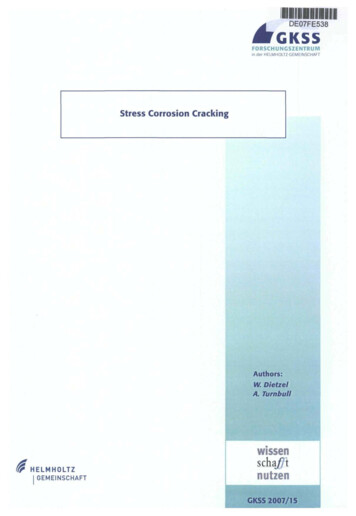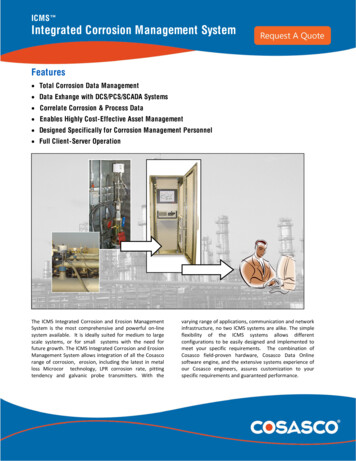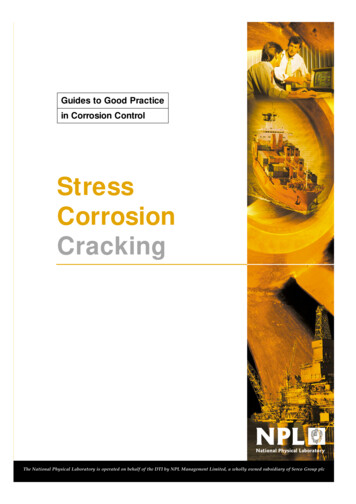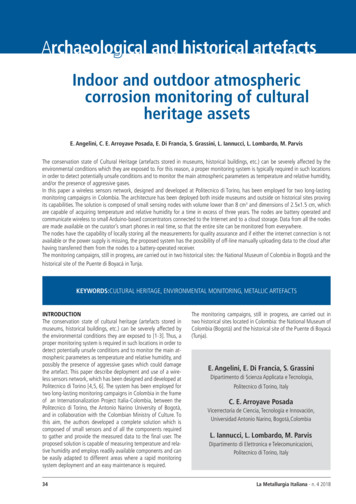
Transcription
Archaeological and historical artefactsIndoor and outdoor atmosphericcorrosion monitoring of culturalheritage assetsE. Angelini, C. E. Arroyave Posada, E. Di Francia, S. Grassini, L. Iannucci, L. Lombardo, M. ParvisThe conservation state of Cultural Heritage (artefacts stored in museums, historical buildings, etc.) can be severely affected by theenvironmental conditions which they are exposed to. For this reason, a proper monitoring system is typically required in such locationsin order to detect potentially unsafe conditions and to monitor the main atmospheric parameters as temperature and relative humidity,and/or the presence of aggressive gases.In this paper a wireless sensors network, designed and developed at Politecnico di Torino, has been employed for two long-lastingmonitoring campaigns in Colombia. The architecture has been deployed both inside museums and outside on historical sites provingits capabilities. The solution is composed of small sensing nodes with volume lower than 8 cm3 and dimensions of 2.5x1.5 cm, whichare capable of acquiring temperature and relative humidity for a time in excess of three years. The nodes are battery operated andcommunicate wireless to small Arduino-based concentrators connected to the Internet and to a cloud storage. Data from all the nodesare made available on the curator’s smart phones in real time, so that the entire site can be monitored from everywhere.The nodes have the capability of locally storing all the measurements for quality assurance and if either the internet connection is notavailable or the power supply is missing, the proposed system has the possibility of off-line manually uploading data to the cloud afterhaving transferred them from the nodes to a battery-operated receiver.The monitoring campaigns, still in progress, are carried out in two historical sites: the National Museum of Colombia in Bogotà and thehistorical site of the Puente di Boyacá in Tunja.KEYWORDS:CULTURAL HERITAGE, ENVIRONMENTAL MONITORING, METALLIC ARTEFACTSINTRODUCTIONThe conservation state of cultural heritage (artefacts stored inmuseums, historical buildings, etc.) can be severely affected bythe environmental conditions they are exposed to [1-3]. Thus, aproper monitoring system is required in such locations in order todetect potentially unsafe conditions and to monitor the main atmospheric parameters as temperature and relative humidity, andpossibly the presence of aggressive gases which could damagethe artefact. This paper describe deployment and use of a wireless sensors network, which has been designed and developed atPolitecnico di Torino [4,5, 6]. The system has been employed fortwo long-lasting monitoring campaigns in Colombia in the frameof an Internationalization Project Italia-Colombia, between thePolitecnico di Torino, the Antonio Narino University of Bogotà,and in collaboration with the Colombian Ministry of Culture. Tothis aim, the authors developed a complete solution which iscomposed of small sensors and of all the components requiredto gather and provide the measured data to the final user. Theproposed solution is capable of measuring temperature and relative humidity and employs readily available components and canbe easily adapted to different areas where a rapid monitoringsystem deployment and an easy maintenance is required.34The monitoring campaigns, still in progress, are carried out intwo historical sites located in Colombia: the National Museum ofColombia (Bogotà) and the historical site of the Puente di Boyacá(Tunja).E. Angelini, E. Di Francia, S. GrassiniDipartimento di Scienza Applicata e Tecnologia,Politecnico di Torino, ItalyC. E. Arroyave PosadaVicerrectoría de Ciencia, Tecnología e Innovación,Universidad Antonio Narino, Bogotá,ColombiaL. Iannucci, L. Lombardo, M. ParvisDipartimento di Elettronica e Telecomunicazioni,Politecnico di Torino, ItalyLa Metallurgia Italiana - n. 4 2018
Storia della metallurgia e beni culturaliTHE MONITORING SYSTEMFig. 1 shows the monitoring system tailored to meet the constraints required for Cultural Heritage applications, for both indoor and outdoor.It consists in a flexible and easily-configurable wireless sensornetwork based on small battery-powered sensing nodes, ableto measure continuously Temperature (T) and Relative Humidity(RH).The nodes can transmit the data to a dedicated receiver usinga wireless radio link working with a proprietary protocol in the2.4 GHz band. The wireless range is 10 - 30 meters, accordingto the environment and the presence of obstacles. The dedicatedreceiver is designed to connect to Internet, so that it is possibleto implement a remote data access based on a dedicated cloudinfrastructure, when a power supply and an Internet connectionare available in the monitored location.Fig. 1 – Environmental monitoring system 3 layer architectureThe low power consumption of the sensing nodes and the optimization of the transmission protocol allow one to achieve aquite long operative sensor life ranging from 1 to 3 years according to the selected battery and to the sampling rate.The simplified block diagram of the nodes is shown in Fig. 2,together with the image of a realized prototype. The core ofthe sensing node is System-on-Chip CC2510 (by Texas Instrument), which features a 8-bits low-power microcontroller anda 2.4 GHz radio transceiver. The firmware running on the microcontroller performs all the operations required for collecting andtransmitting the data. A non-volatile flash memory allows an onboard permanent data storage, guaranting a permanent backupof more than 125000 measurements. Temperature and relativehumidity are measured by a digital sensor type SHT21 (by Sensirion), which provides an uncertainty of 0.3 C and 2% for T andRH, respectively. The sensor communicates with the microcontroller using a I2C interface and it is periodically disabled in orderto reduce power consumption. The node sampling rate can beLa Metallurgia Italiana - n. 4 2018selected by the user from 1 s to 3600 s. The clock crystal is usedfor generating the microcontroller main clock and the transceivercarrier, while an antenna allows the wireless communication. Thenodes are battery operated and enclosed in a 3D-printed box (25x 16 mm), which can be realised in different shape, material andcolor in order to be compatible and less invasive for the differentenvironments.Sensor nodes work autonomously without any attendance for alltheir operative life, storing the data in the non-volatile internalmemory. If an on-line receiver is positioned within the operativerange of the nodes, they continuously transmit the acquired dataand the receiver pushes such data on the cloud using the Internet connection. In locations where this approach is not possible,an USB receiver can be connected to a laptop for periodicallydownloading the data. These features of the monitoring systemhave proven to be useful in the Cultural Heritage field, becausethey make the system flexible, accurate and secure against tampering and data loss.35
Archaeological and historical artefacts(a)(b)Fig. 2 - The simplified block diagram of the sensor node (a), sensor prototype (b)INDOOR MONITORING CAMPAIGNThe indoor monitoring campaign has been carried out at theNational Museum of Colombia. This National Museum is the oldest in the country and one of the oldest in the continent, builtin 1823. Its fortress architecture is built in stone and brick; theplant includes arches, domes and columns forming a sort ofGreek cross over which 104 prison cells were distributed, withsolid wall façade. It was known as the Panóptico and served asa prison until 1946. In 1948 was adapted for National Museumand restored in 1975. The museum hosts a collection of morethan 20000 artefacts, pre-Colombian archaeological and ethnographic artefacts, paintings and textiles belonging to differenthistorical periods. Several artefacts are affected by degradationprocesses, and the monitoring activity aims to determine if thereis a correlation between the conservation state, in particular ofmetallic and textile artefacts, and the environmental conditionsinside the showcases.Six sensor nodes have been placed in different locations insidethe museum, showcases and deposits. The locations have beenselected taking into account the different materials that constitute the artefacts, their conservation state and the type of enclosure they are stored within.The monitoring system was deployed in July 2017 and the environmental monitoring activity is still in progress. In order toacquire meaningful information on the indoor environment, Cubased reference specimens were exposed to the indoor atmosphere inside several showcases. The reference specimens areboth as-received or coated with a Cu nanostructured thin filmdeposited by plasma sputtering, in order to increase their reactivity. This allows one to observe surface degradation phenomenaand to analyse them as a function of time.Fig. 3 shows two of the showcases, under study, with bronzeand gold artefacts, where the sensor nodes S35 and S45 havebeen placed. Sensor S35 is located in room 13, “Custodia”, alarge room at the first floor. The image inset also shows a detailsof the Cu coupons. Sensor S45 is located in room 6, Boveda ‘Eloficio del Orfebre’, in the showcase ‘Tumba de pozo con camara’,an armored room, at the ground floor.(a)(b)Fig. 3 – Sensors and Cu reference samples positioning in the National Museum of Colombia. (a) sensor S35 located in room 13; (b)sensor S45 located in room 6.36La Metallurgia Italiana - n. 4 2018
Storia della metallurgia e beni culturali(a)(b)Fig. 4 – Temperature (T) and Relative Humidity (RH) trends recorded by (a) S35 located in room 13 and (b) S45 located in armoredroom 6.La Metallurgia Italiana - n. 4 201837
Archaeological and historical artefactsIn Fig. 4 the temperature and relative humidity data recorded bymeans of nodes S35 and S45 for more than two months, fromJuly 2017 to half september 2017, are reported.The experimental findings show clearly the circadian variationof temperature: excursions along the monitoring period are ofabout two Celsius degrees for room 13 and of less than 1 C forthe armored room 6 which has a lower air circulation.In room 13 the variation of the temperature is from 16 to 21 C,but the variation of relative humidity is negligible and remainsaround 60%. Data collected from node S45 show that when thearmored room 6 is opened, four times a week, T and RH exhibitmoderate variations and that, when the room remains closed,the values slowly return to the baseline values, T 19 C, RH 62%.Relative humidity reaches sligtly higher values with respect tothe other monitored rooms, due to the fact that the armoredroom is in the ground floor meanwhile the other monitoring sitesare located at the first floor of the building.Both the environmental conditions may be considered quite safefor the conservation of the artefacts. However the microscopicexamination of the surfaces of the copper reference sampleshighlights a difference in the reactivity of the two-nanostructured copper samples.Fig. 5 shows the FESEM images of the copper nanostructuredspecimens after three months of exposure in both the rooms respectively. The morphological analysis highlights the quite safeenvironmental conditions inside the showcase of room 13.As a matter of facts, no significant corrosion presence can beobserved onto the surface of the Cu nanostructured film, whichmaintains its well-defined nanostructure.Meanwhile the relative humidity fluctuations of the showcase inthe armored room 6, cannot be considered totally safe for theartefacts conservation, even if the atmosphere is not aggressiveenough to induce localized corrosion attacks on the copper reference samples, which can significantly affect the artefacts stabilityand long-time conservation.However, due to the higher susceptibility to atmospheric corrosion, the Cu-nanostructured layer shows a localized attack whichleads to a coalescence of the copper nanoclusters and a subsequent detachment.The presence of corrosion attacks, with dimensions of few micrometers, may be attributed to the presence of a slightly higheraggressive air, due to the fact that the armored room si closedmost of the time.Fig. 5 – FESEM images of the Cu nanostructured reference samples exposed for 3 months close to node S35 located in room 13, andto node S45 located in the armored room 6.OUTDOOR MONITORING CAMPAIGNThe outdoor monitoring campaign has been carried out at theCampo de Boyacá, also known as Puente de Boyacá, an historical site located at 110 km east of Bogotá, crossing Teatinos river.This site gained a large popularity in Colombia as numerousmonuments have been erected in the surroundings of a smallbridge (the Puente de Boyacá) to commemorate the historicbattle of 7th August 1819, known as the Battle of Boyacá, whichgranted independence to New Granada.The bridge was built in the early 18th century, and was dedicatedas National Monument and memorial of independence in 1920.The other National Monuments present in the park are a triumphal arch, an obelisk and a flags square. Moreover, the metallic38statue of Francisco de Paula Santander, the monument of PedroPascasio Martínez and, on the hill, the Von Miller Monument arealso part of this important historical site. The Von Miller Monument, shown in Fig. 6, is a bronze monument composed by fiveallegoric female figures, symbolic of Colombia, Venezuela, Peru,Ecuador and Bolivia, holding Simón Bolívar (1783-1830), the liberator from the Spanish government and the first president ofGran Colombia.The bronze statues of the Von Miller monument are apparentlyin a quite good conservation state even if tourists are allowedto climb the monument, risking of removing the surface patinagrown on the metal by the interaction with the atmosphere.However, this anthropic damage is less important respect toLa Metallurgia Italiana - n. 4 2018
Storia della metallurgia e beni culturalithe atmospheric conditions the statues are exposed to. Actually,the monument is located at an altitude of about 2800 m andis exposed to a subtropical climate. In this geographical region,temperature remains all over the year in the range 7- 17 C, withan alternation of more or less dry and rainy seasons, but with ahigh possibility of rain every day. As a matter of facts, the relativehumidity can reach 90-100% every day all over the year, leavingthe monument exposed to atmospheric corrosion in very aggressive conditions.Fig. 6 – The Simon Bolivar bronze statue in the Puente de Boyacá, an historical site built in the early 18th century, memorial of independence in 1920.La Metallurgia Italiana - n. 4 201839
Archaeological and historical artefactsThe monitoring activity started in July 2017 at the Puente deBoyacá. The measurement data, acquired by the node S49 onthe Von Miller Monument (Simon Bolivar statue) for more thantwo months, are reported in Fig. 7. The collected data show verylarge daily variations of both temperature and relative humidityof about 20 C and 50 %RH. Specifically, the measurements letone to observe how the humidity can get close to 100% duringthe night with the risk of water condensation on the statues.These environmental conditions are very harsh, being the site at2800 m on the sea level in a tropical region, and can severelyaffect the conservation of the metallic staues maily due to thepossibility of repeated water condensation.Fig. 7 – Temperature and relative humidity recorded by the sensor S49 at Puente de Boyacá (Von Miller Monument).CONCLUSIONSThe presented system reveals to satisfy the typical requirementsfor Cultural Heritage monitoring both indoor and outdoor. It hasbeen very effective in the monitoring activities providing accuratedata useful for evaluating the climatic conditions closed to theartefacts.This information especially if coupled with the deployment ofcoupon to observe the presence of aggressive componds, can beused by conservators and curators for improving the artifact conservation and detecting possible unsafe situations. The campaign40is still in progress and new data are continuously collected by themonitoring system in order to better evaluate the environmentalconditions along a more extended time period.AcknowledgementsThe research has been financially supported by Compagnia diSan Paolo, in the frame of an “Internationalization Project ItalyColombia”, with the Antonio Narino University of Bogotà, and incollaboration with the Colombian Ministry of Culture.La Metallurgia Italiana - n. 4 2018
Storia della metallurgia e beni culturaliREFERENCES[1][2][3][4][5][6]D. Camuffo et. al, “Environmental monitoring in four European museums”, Atmospheric Environment, Vol.35, supp.1, 2001, pp.S127-S140.A. Kumar; H. Kim; G. P. Hancke, “Environmental Monitoring Systems: A Review”, IEEE Sensors Journal, vol. 13, no. 4, pp. 13291339, 2013.N. Kularatna, B.H. Sudantha “An Environmental Air Pollution Monitoring System Based on the IEEE 1451 Standard for Low CostRequirements”, IEEE Sensors Journal, vol. 8, no. 4, pp. 415-422, 2008.E. Angelini, S. Corbellini, D. Fulginiti, S. Grassini, M. Parvis, “Innovative monitoring campaign of the environmental conditions of theStibbert museum in Florence”, Applied Physics A, 2016, 122S. Grassini, E. Angelini, A. Elsayed, S. Corbellini,L. Lombardo, M. Parvis “Cloud Infrastructure for Museum Environmental Monitoring”, Proceedings of I2MTC 2017, pp. 1840, 1845.L. Lombardo, S. Corbellini, M. Parvis, A. Elsayed, E. Angelini, S. Grassini, "Wireless Sensor Network for Distributed EnvironmentalMonitoring", IEEE Transactions on Instrumentation and Measurement, 2018, DOI: 10.1109/TIM.2017.2771979.La Metallurgia Italiana - n. 4 201841
The monitoring system was deployed in July 2017 and the en-vironmental monitoring activity is still in progress. In order to acquire meaningful information on the indoor environment, Cu-based reference specimens were exposed to the indoor atmo-sphere inside several showcases. The reference specimens are
